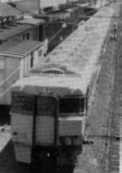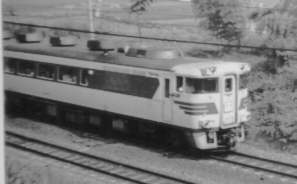|
Freight transport in JNR
In the world, a gas turbine for
railroad was first applied to the locomotive power source. But in Japan, a gas turbine
locomotive had not been planned. In 1960's the freight transport in
Japanese National Railways was declining from year to year. Mass
produced diesel locomotives such as type DD51 had already been becoming
surplus.
After Japan Freight Railway took over JNR, more high power non-electric
locomotive was required to resolve the double heading of DD51. But
already diesel had the ability to resolve this and AC electric driven
diesel locomotive, DF200 was developed
If the freight transport in those days did not
decline and the rail transport remained to play a main role, an EF66
class non-electric locomotive may be required. To realize this class of
non-electric locomotive, there were no other choice except for a gas
turbine.
But like Union Pacific Big Blow, high performance diesel locomotives
might have replaced them.
Speed up project for conventional lines
In 1960s, a train's speed in Japanese
conventional lines was gradually increased and reduced journy time. In
1966 diesel powered rail car kiha 82 enabled the limited express train
network spread all over Japan. The maximum operating speed of the EMUs were 110km/h  and
DMUs 100km/h. Next speed up project targeted the maximum speed of 120km/h.
EMUs already had the sufficient performance to achieve this speed but DMUs
didn't. For this purpose, high performance DMUs, kiha 90 and kiha 91
were developed and they were expected to
offer nearly similar speed to EMUs on flat routes. Based on these tests,
series kiha 181 express train and
DMUs 100km/h. Next speed up project targeted the maximum speed of 120km/h.
EMUs already had the sufficient performance to achieve this speed but DMUs
didn't. For this purpose, high performance DMUs, kiha 90 and kiha 91
were developed and they were expected to
offer nearly similar speed to EMUs on flat routes. Based on these tests,
series kiha 181 express train was produced and put into commercial operation.
was produced and put into commercial operation.
Next goal was to speed up on curves because conventional lines
especially in non-electrified areas had many
steep curves and kept trains from speeding up.
To speed up on curves, a light weight and low center of gravity and
centrifugal force free car was required. By using EMU system, many part
of these issues were to be resolved, but DMU system in those days could
not resolve due to its heavy and balky power source. To reduce the
centrifugal force on curves, a tilting system was required. An active
tilt system is better than a passive one but it was very difficult to
build safe and reliable active tilt system. In Europe, APT, TGV and some
other trial and plan had already existed to utilize the passive tilt
system, but all of them gave up and abandoned.
In 1970, series 591 EMUs was built to test a passive tilting mechanism
and articulated formation.
To overcome the diesel performance limitation, a turbine's high
performance had come to draw a lot of attention.
Go to top of this page
|
 and
DMUs 100km/h. Next speed up project targeted the maximum speed of 120km/h.
EMUs already had the sufficient performance to achieve this speed but DMUs
didn't. For this purpose, high performance DMUs, kiha 90 and kiha 91
were developed and they were expected to
offer nearly similar speed to EMUs on flat routes. Based on these tests,
series kiha 181 express train
and
DMUs 100km/h. Next speed up project targeted the maximum speed of 120km/h.
EMUs already had the sufficient performance to achieve this speed but DMUs
didn't. For this purpose, high performance DMUs, kiha 90 and kiha 91
were developed and they were expected to
offer nearly similar speed to EMUs on flat routes. Based on these tests,
series kiha 181 express train was produced and put into commercial operation.
was produced and put into commercial operation.